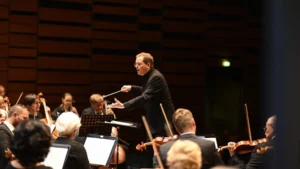The first and main intention of a musical arrangement is to respect the original music. And that’s all. In other words, a musical arrangement is an art form in its own right but, at the same time, it is a subsidiary element of a larger narrative. So, with this guiding idea in mind, we can answer our original question. What role does the musical arrangement play?
This is not (just) a rhetorical question. Although there is room for many subjective interpretations, we can narrow the scope and address the specifics. For example, a musical arrangement can translate a piece of music from one genre to another, or from a simple piano sketch to a specific genre. Or we may be faced with the practical necessity of arranging a song for a particular set of instruments.
We can cite 4 major situations in which we would need a musical arrangement:
- Change genre (or key/style)
- Adapt instrumentation
- Expand emotional or dynamic range
- Create a medley/mash-up with different songs
Of course, these situations can be intertwined because the distinction between one and the other is not always very clear. But there are objective principles that help produce musically effective results. The presence of rules in music, contrary to popular belief, does not restrict creativity.
In fact, creativity emerges when you understand the limits and know how to deal with them. Also, certain instrumental combinations can produce powerful and versatile devices that convey all the emotions we want to evoke.
It is therefore up to the arranger to know what is possible and what is not.
Let’s talk a bit about these general principles that govern the musical arrangement, because they allow the arranger to achieve one of the four situations mentioned above.
A small caveat: these great ideas are by no means all about the art of arrangement. These principles will simply help you understand the difference between arranging and, say, songwriting, as they are based on the specifics of an instrumentation. concrete.

Understand how texture (style) works.
From a classical point of view, the concept of texture (1) refers to how the different musical elements work with each other in a coherent way.
We can think of texture in terms of density (number of layers) and activity (degree of rhythmic activity of each layer). As with any art form, the whole is more than the sum of its parts.
Music is no exception, as the combined result of these layers and their specific activity can produce a certain type of sound which, if developed consistently over time, can be considered a ” style” or a “genre”.
Part of a music arranger’s job is to “reverse engineer” a specific style to see how it works and what elements are present.
This is only the first step: understanding the language. Now, with that in mind, the original hardware will need to be adapted in order to work with these new settings while retaining its essence.
Stamp = Emotion.
Timbre is a physical phenomenon that gives each instrument or set of instruments specific characteristics.
We can associate this idea with the colors of a painting. Stamps are usually described with rather poetic words: dense, thick, light, warm, cold, rough, soft, etc.

Indeed, for our artistic needs, the scientific parameters with which we can measure timbre are not really useful. Some timbres are associated with particular emotions or situations. This phenomenon has its origins in the Baroque period.
In fact, the musical meanings and rhetorical conceptions of this time are analyzed in what is called theme theory (2). These connotations have developed and expanded over time and are now part of our cultural heritage.
But they are not necessarily restrictions. A musical arranger can exploit them with different approaches. The important thing is to use the timbres to convey the emotion that emerges from the music that has been arranged.
Use the frequency spectrum effectively.
This aspect is more technical and practical than the others.
Due to the way our biological auditory system works, we process frequencies approximately logarithmically. We tend to perceive more low and mid-frequencies, and less high frequencies.
This physical phenomenon must be taken into account when arranging, but not with such a rigorous scientific approach.
In practical terms, a musical arrangement must take these three registers into account.
First of all, the bass instruments must be given enough space so that they can dominate the register without the sounds colliding. This is why a single bass instrument is sometimes enough to propel the harmonic progression.
Second, pay close attention to the middle register (where most of the melodies and lyrics are), and don’t create a mess. This frequency range is also quick to build up easily if the arrangement does not distribute the voices accordingly.
Finally, the high register should be used deliberately to avoid harshness. This is where all the “magic” and sparks reside, but too much of this frequency can become exhausting to the listener.
Less is more.
This last principle is not specific to a musical arrangement, but it is always good to have it present.
Remember the concept of reverse engineering to extract elements of a particular genre or style? Well, that’s exactly where the “Less is More” principle applies.
Because our perception can make immediate associations without having all the information in hand, a powerful resource in musical arrangements is the “synecdoche”. This figure of Greek speech can also be applied to music.
By suggesting even a slight taste of a specific genre or style (a guitar riff, a rhythmic pattern, the appearance of a new instrument timbre, etc.), we can convey instantly the idea that we are trying to communicate. Thus, we leave a creative space to explore new and interesting territories.

Conclusion
As we have seen, the underlying principle of this article is that a musical arrangement requires an original source in order to fulfill its purpose.
That being said, we can separate musical arrangement from other types of musical craftsmanship like songwriting, composing film scores, or composing original music. Although it shares techniques with these other fields, it has the sole purpose of beautifying and giving a new perspective to an existing material.
We can consider the musical arranger as a haute couture tailor, for songs or pieces of music. Clothes can be beautiful, but if you end up paying more attention to fabric or colors than the character wearing them, then you’ve completely missed the mark.
A good musical arrangement elevates the original music. It gives fresh air. It creates a new environment in which the music speaks some of its truths that were, for one reason or another, harder to hear before. Ultimately, the musical arranger will have to dig deep to uncover these truths.
(1) In the classical tradition, the most common textures in music are: monophonic, polyphonic or contrapuntal, homophonic, accompanied melody, heterophonic, etc.
(2) For more information on theme theory, you can read Ratner (1980) in his book “Classic Music: Expression, Form, and Style”.











